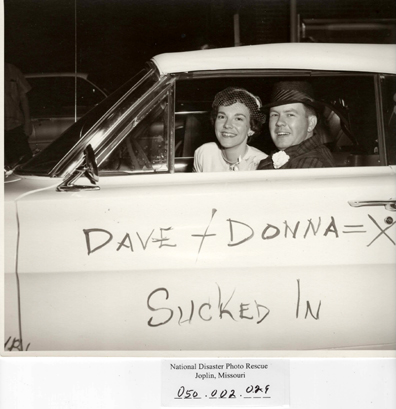
May 22 marked the third anniversary of the powerful tornado that struck Joplin, Missouri, and changed that Route 66 city forever.
I recommend you read this story from Al-Jazeera America about the Lost Photos of Joplin project, which collected more than 40,000 photographs scattered by the storm.
There are lithographs of ancestors from the 1800s, black-and-white photos from World War II, family vacation memories, baby photos, school pictures, big-haired prom shots from the 1980s, Polaroids from Christmas morning, developed film from school plays — there are even a few that made some of the women of the church blush, Beeler said with a laugh.
The rest of Joplin’s photos have since been moved from First Baptist in Carthage to the Joplin Museum Complex, where they will be permanently stored. Beeler considers what his group has done a success, even though tens of thousands of photos remain unclaimed. He knows some people may not even be aware of the project, and that it may be too painful for some to come collect photos of their lives from before the tornado.
He knows some of the pictures are of people who died in the storm, and will never be claimed.
Thad Beeler, who organized the photo-collection effort with the church and many other volunteers, hopes their work can also be done in other disaster-stricken towns across the country, including the recently tornado-hit towns of Quapaw, Oklahoma, and Baxter Springs, Kansas.
The tornado’s destruction still beggars belief. With 161 dead, it was the deadliest tornado in the United States in more than 60 years. It injured more than 1,100, destroyed about 2,000 buildings, and caused nearly $3 billion in damage.
The Al-Jazeera report also collected vivid memories of the disaster:
Chattelier recalled feeling the suction of the storm as her husband lay on top of her, holding on to a support beam. When she opened her eyes, her glasses had been torn from her face. The things she had in her pockets were gone, replaced with debris. They found her daughter’s car at the top of a tree blocks away with massive gashes in it. […]
In the days following the tornado, stories emerged that illustrated how horrifying the power of the storm had been. Hospital patients had been sucked out of their beds and out of the windows. Entire stores disintegrated while people huddled inside. Some victims could never be identified.
I didn’t get to Joplin for days after the tornado, but followed it closely the night it happened through Twitter and the Internet. I knew it was bad because of one thing in particular: An officer on the police radio mentioned taking someone to “the temporary morgue.”
(Image of one of the many thousands of unclaimed photos from the Joplin tornado)